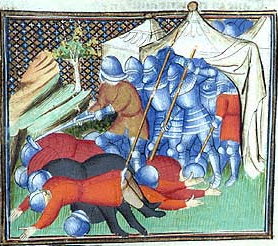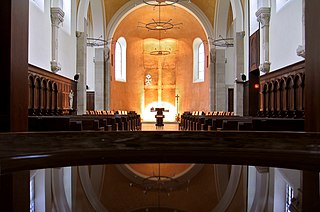
Meaux is a commune in the Seine-et-Marne department in the Île-de-France region in the metropolitan area of Paris, France. It is 41.1 km (25.5 mi) east-northeast of the center of Paris.

The Agilolfings were a noble family that ruled the Duchy of Bavaria on behalf of their Merovingian suzerains from about 550 until 788. A cadet branch of the Agilolfings also ruled the Kingdom of the Lombards intermittently from 616 to 712. They are mentioned as the leading dynasty in the Lex Baiuvariorum. Their Bavarian residence was at Regensburg.

Coupvray is a commune in the Seine-et-Marne department in the Île-de-France region in north-central France.
Odo II was the count of Blois, Chartres, Châteaudun, Beauvais and Tours from 1004 and count of Troyes and Meaux from 1022. He twice tried to make himself a king: first in Italy after 1024 and then in Burgundy after 1032.

Aripert I was king of the Lombards (653–661) in Italy. He was the son of Gundoald, Duke of Asti, who had crossed the Alps from Bavaria with his sister Theodelinda. As a relative of the Bavarian ducal house, his was called the Bavarian Dynasty.

The Siege of Meaux was fought in 1421-1422 between the English and the French during the Hundred Years' War. The English were led by King Henry V. Henry became ill while fighting this long battle, which took place during the winter months. He died on 31 August as a result.
The Bavarian dynasty was those kings of the Lombards who were descended from Garibald I, the Agilolfing duke of Bavaria. They came to rule the Lombards through Garibald's daughter Theodelinda, who married the Lombard king Authari in 588. The Bavarians were really a branch of the Agilolfings, and were themselves two branches: the branch descended in the female line through Garibald's eldest child and daughter, Theodelinda, and the branch descended from Garibald's eldest son Gundoald. Of the first branch, only Adaloald, Theodelinda's son by her second husband, whom she had chosen to be king, Agilulf, reigned, though her son-in-law Arioald also ruled. Through Gundoald, six kings reigned in succession, broken only by the usurper Grimuald, who married Gundoald's granddaughter:
Robert of Vermandois was Count of Meaux and Count of Troyes, son of Herbert II, Count of Vermandois and his wife, Adele of France, daughter of Robert I of France.
Austrovald, Astrobald, and Austrevald was the Duke of Aquitaine from 587.
Mummolus, was a Gallo-Roman patrician and prefect who served Guntram, King of Burgundy, as a general in the 6th century.
Burgundofara, also Saint Fara or Fare, was the founder and first Abbess of the Abbey of Faremoutiers. Her family is knowns as the Faronids, named after her brother Saint Faro. Her name may mean: 'She who moves the Burgundians'
Saint Faro, Count of Guines, was bishop of Meaux. The family to which Faro belonged is known as the Faronids and is named after him.

Originally, the Duchy of Chartres was the comté de Chartres, a County. The title of comte de Chartres thus became duc de Chartres. This duchy–peerage was given by Louis XIV of France to his nephew, Philippe II d'Orléans, at his birth in 1674. Philippe II was the younger son and heir of the king's brother, Philippe de France, Duke of Orléans.
Gundoald was a Bavarian nobleman of the Agilolfing family, a son of Duke Garibald I and Walderada, and the Duke of Asti from sometime around 589.

Jouarre Abbey is a Benedictine abbey in Jouarre in the département of Seine-et-Marne.
Ingunde, Ingund, Ingundis or Ingunda,, was the eldest child of Sigebert I, king of Austrasia, and his wife Brunhilda, daughter of King Athanagild of the Visigoths. She married Hermenegild and became the first Catholic queen of the Visigoths.
The Prince of Darkness is a term used in John Milton's poem Paradise Lost referring to Satan as the embodiment of evil. It is an English translation of the Latin phrase princeps tenebrarum, which occurs in the Acts of Pilate, written in the 4th century, in the Historia Francorum by Gregory of Tours, in the 11th century hymn Rhythmus de die mortis by Pietro Damiani, and in a sermon by Bernard of Clairvaux from the 12th century.
Events from the year 1593 in France
This page is based on this
Wikipedia article Text is available under the
CC BY-SA 4.0 license; additional terms may apply.
Images, videos and audio are available under their respective licenses.






